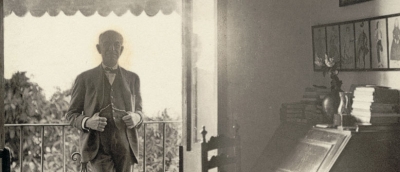
GRANADA, THE CHOSEN CITY
The first composition he wrote in Granada is dated August 1920: this is Homenaje pour le Tombeau de Claude Debussy, a work for guitar written in memory of the French composer, who had died in 1918. Curiously, Falla’s move to Granada coincided with a change in his musical orientation away from the popular Andalusian subject matter of his earlier works.
Meanwhile, Falla’s relationship with the Martínez Sierras finally foundered as a result of Don Juan de España, a collaborative project on which they had barely started. This work reached the Madrid stage in November 1921, but without the music that Falla had planned to write for it. Towards the end of the month, on the twenty-fourth, the composer wrote a stern letter to Gregorio Martínez Sierra which includes, among other things, the following:
My only purpose in writing this letter is to ask you to write one to me, confessing in your own hand the absolute truth of the matter: that the basic idea of the last two scenes or acts […] was mine, and promising me at the same time that no musical adaptation of the work will be permitted in which those scenes are included, nor any other scenes that I suggested to you22[22] Handwritten draft of a letter from Manuel de Falla to Gregorio Martínez Sierra, dated Granada, 24 November 1921. A.M.F. (correspondence folder 7251)..
Gregorio Martínez Sierra’s pain and disgust at what he regarded as an insult from an old friend is plain to see in his reply of 26 November. In its penultimate paragraph, he wrote:And now in all seriousness: so that you need fear no longer, and so that I no longer have to feel offended, I’d be grateful if you would send me by return of post – registered – a list of all the musical “scenes” that you suggested to me so that I can erase them from my memory and not fall prey to the temptation to make use of someone else’s ideas. There are things here that […] hurt more than you can guess, because you have so much dramatic ingenuity and imagination23[23] Handwritten letter from Gregorio Martínez Sierra to Manuel de Falla, dated Madrid, 26 November 1921. A.M.F. (correspondence folder 7251)..
The place formerly occupied by the Martínez Sierras in the composer’s spirit and aspirations was now taken by new friends in Granada, through whom Falla came into contact with new young associates, including “los rinconcillistas”, a group of friends who gathered in a café in the city centre. Among the members of the group closest to Falla were Federico García Lorca, Manuel Ángeles Ortiz and Hermenegildo Lanz.Towards the end of 1921, Falla found what was to become his definitive home in Granada: a small house with its own walled garden in the Antequeruela Alta. That house, in which he lived with his sister María del Carmen, was the scene of regular visits from their friends in Granada, and also from the many foreigners who wished to meet the composer, among them musicians, writers and artists. In Silla del Moro y nuevas escenas andaluzas, Emilio García Gómez recalls those evenings at Falla’s house:
Everything was plain, simple and clean […]. A few local friends would be conversing with Falla, all seated on wicker chairs around the circular table. María del Carmen’s cat would be purring in a corner […]. Almost anything would be discussed in preference to music. The composer would ask questions and listen to replies; when he interrupted, he would surprise you with his exquisite courtesy. Nobody there had any idea of Falla’s inner torments24[24] GARCÍA GÓMEZ, Emilio. Silla del Moro y nuevas escenas andaluzas. Madrid, Revista de Occidente, 1948, p. 133..




